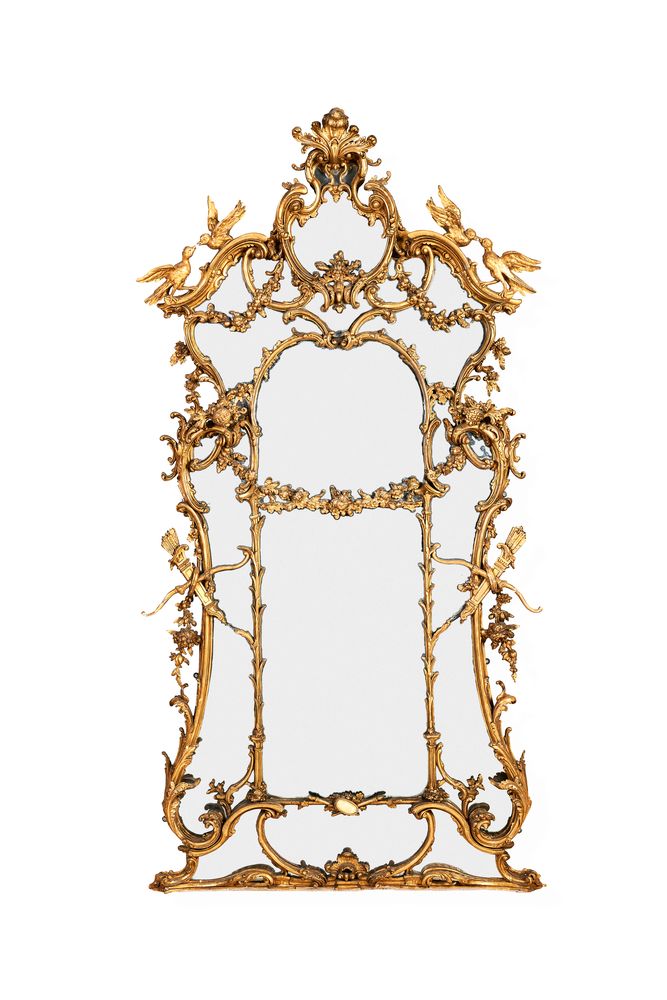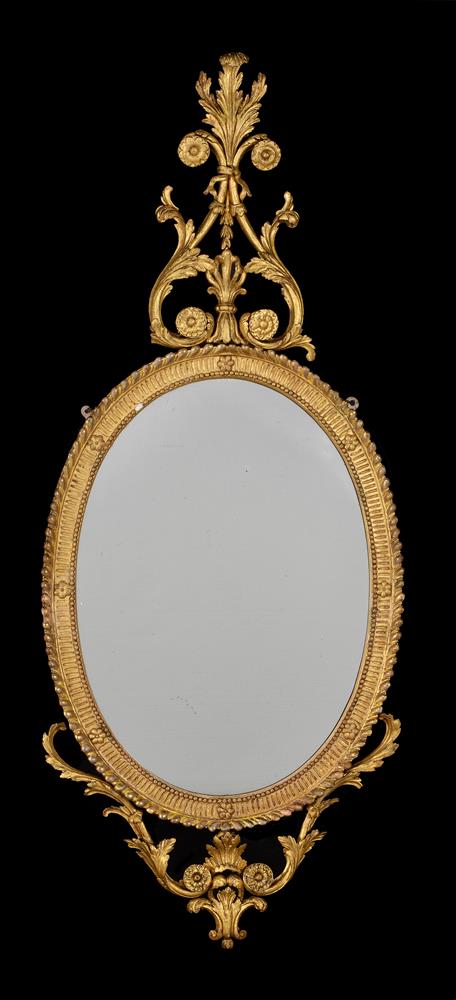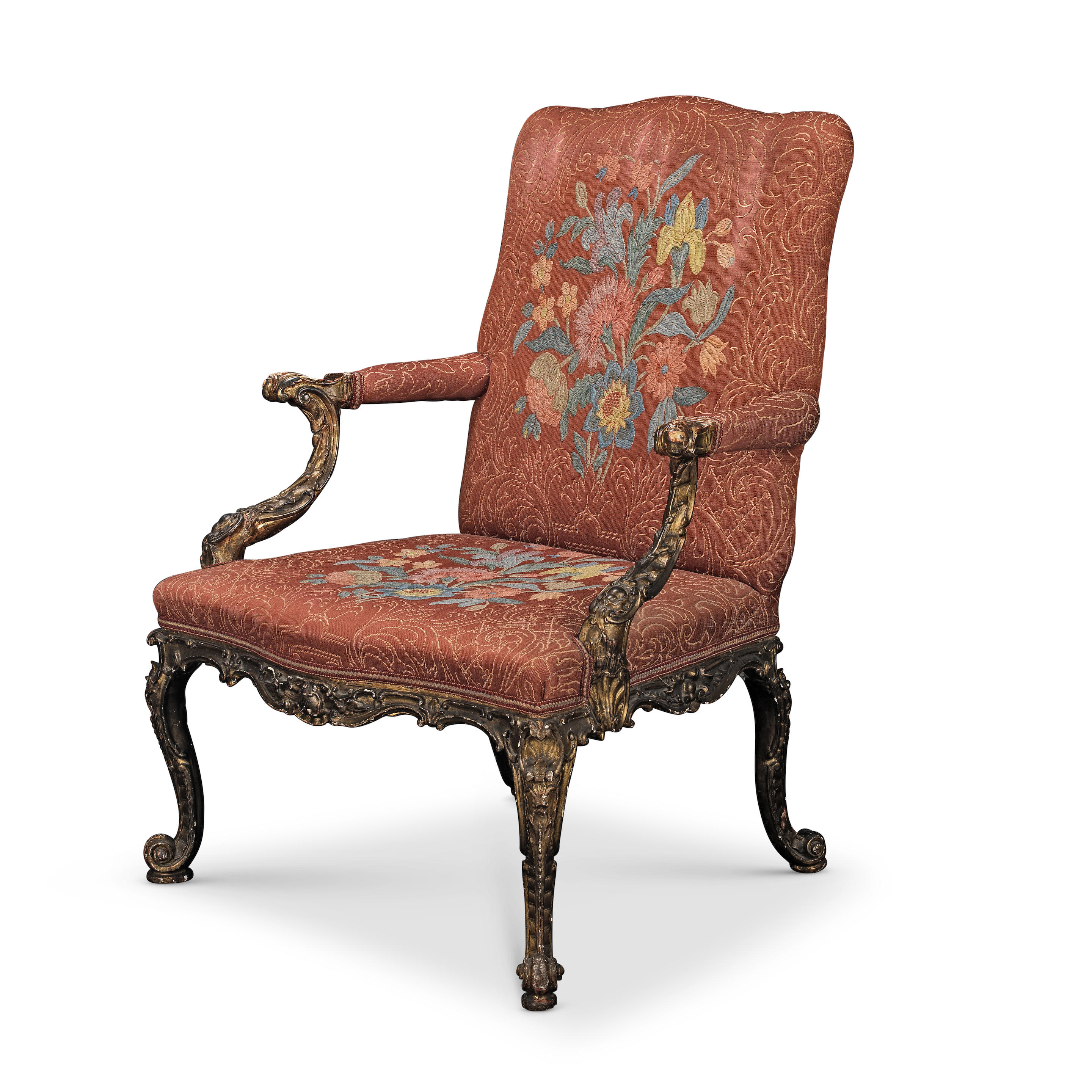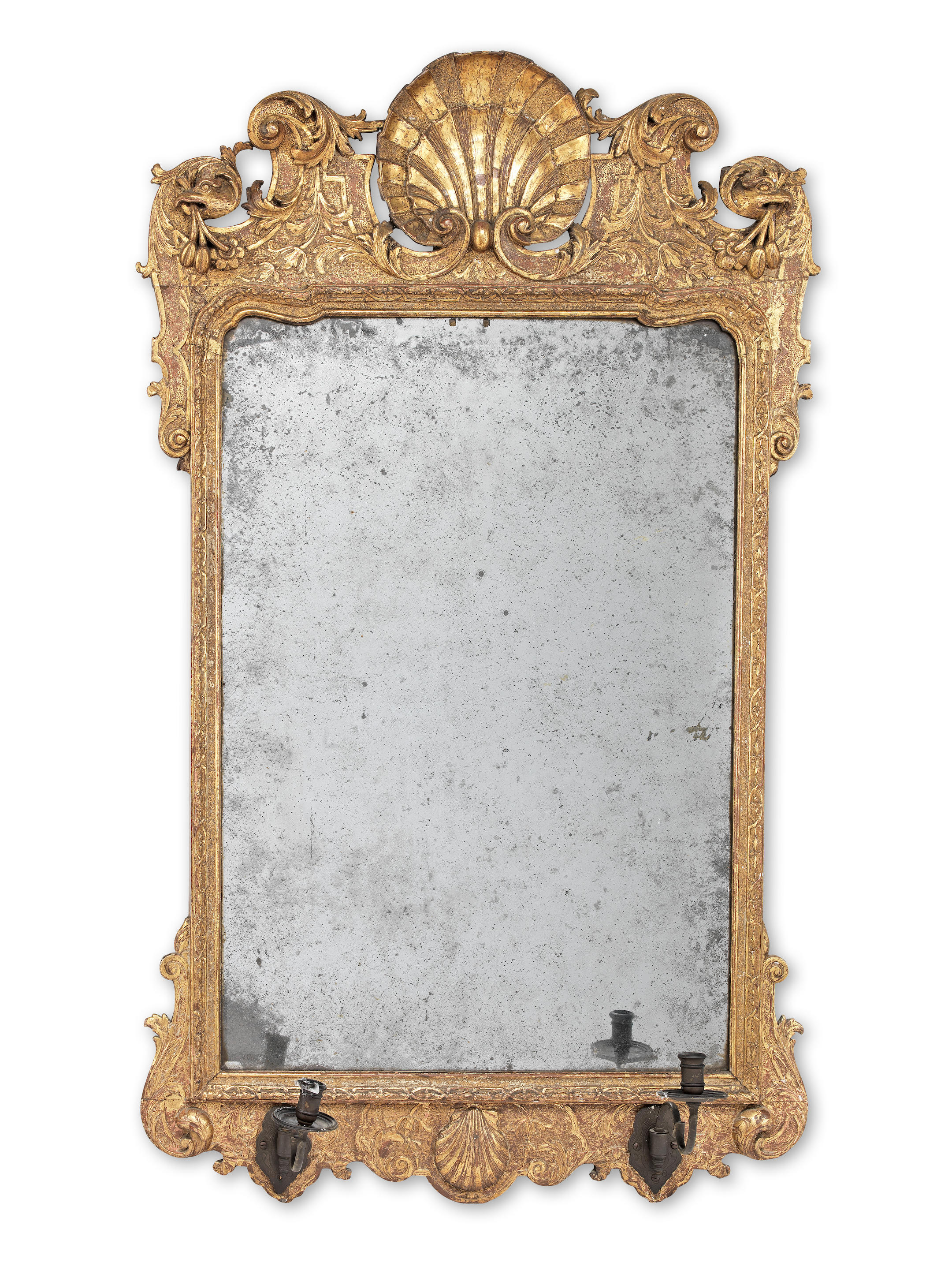A fine English giltwood pier mirror , 18th century and later, in the manner of Linnell, of elaborate rococo design, the scrolling foliate frame with a cartouche shaped cresting above a swan-neck pediment flanked by ho-ho birds, the multi-panelled plate decorated with floral swags and a pair of bows with quivers, 261cm high, 135cm wide, re-gilt and some mirror plates replaced Provenance: The Earls of Craven, Combe Abbey Cornelia, Countess of Craven Sold at Sotheby's in the 1960s as 'Property of a noblewoman' This elaborate giltwood pier mirror designed in the French rococo taste has affinities with the work of the celebrated cabinet-making father and son partnership of William (d. 1763) and John Linnell (d. 1796) of Berkeley Square, London. The Linnells were one of the leading cabinet-making firms of the 18th century who supplied furniture and decorations for a number of important country estates including, Alnwick Castle, Shardeloes, Inverary Castle Kedleston Hall, Badminton House, Osterley Park, Syon Park, Bowood House and Lansdowne House. The design of the present mirrors appears to be derived from a combination of elements featured in patterns for pier glasses of circa 1755-60 by the Linnell firm, held in the Victoria & Albert Museum collection (see H. Hayward, P. Kirkham, William and John Linnell Eighteenth Century London Furniture Makers , London, 1980, vol. II, pp. 94-99, figs. 180-190; H. Hayward, 'The Drawings of John Linnell in the Victoria and Albert Museum', Furniture History , vol. 5, 1969, figs. 46, 47, 48 and 76). A pair of rococo mirrors of related form likewise associated with John Linnell is recorded at Bramshill, Hampshire (see R. Edwards, The Dictionary of English Furniture, rev. ed., 3 vols vol II,p.339, fig. 75) Coombe Abbey Coombe Abbey was originally built in the 12 th century for use as a monastic institution for the Cistercian order, known as the Abbey of Cumbe. After several changes of ownership the Abbey was then bought in 1622 by Lady Elizabeth Craven widow of Sir William Craven , mayor of London who settled the property on her son, Lieutenant General William Craven 1 st Earl Craven (1608-1687) . In 1662, Elizabeth died and left her son, the 1 st Earl, her collection of Stuart Family paintings which included pictures by masters such as Rubens, Van Dyck and Honthorst. These pictures remained at Combe Abbey until the beginning of the 20 th century. The Abbey was passed through successive generations until 1769 when it became the home of William Craven 6th Baron Craven . In 1771 he commissioned the famous landscaper Capability Brown to modernise the landscaping around the property. In 1825 William Craven 2nd Earl of Craven succeeded to become the owner of Coombe Abbey. In 1860 he engaged William Eden Nesfield to carry out major alterations to the house at Combe. The east wing and part of the north wing were demolished and rebuilt in a completely different style, the main facade we see today. It is likely that the present lot was acquired to furnish these alterations. The last Earl of Craven to live in Coombe Abbey was William Craven 4th Earl of Craven. When he died in 1921 his widow Cornelia, Countess of Craven decided to sell the property in 1923 along with most of its contents. This was eventually sold in the 1960s at Sothebys.
A fine English giltwood pier mirror , 18th century and later, in the manner of Linnell, of elaborate rococo design, the scrolling foliate frame with a cartouche shaped cresting above a swan-neck pediment flanked by ho-ho birds, the multi-panelled plate decorated with floral swags and a pair of bows with quivers, 261cm high, 135cm wide, re-gilt and some mirror plates replaced Provenance: The Earls of Craven, Combe Abbey Cornelia, Countess of Craven Sold at Sotheby's in the 1960s as 'Property of a noblewoman' This elaborate giltwood pier mirror designed in the French rococo taste has affinities with the work of the celebrated cabinet-making father and son partnership of William (d. 1763) and John Linnell (d. 1796) of Berkeley Square, London. The Linnells were one of the leading cabinet-making firms of the 18th century who supplied furniture and decorations for a number of important country estates including, Alnwick Castle, Shardeloes, Inverary Castle Kedleston Hall, Badminton House, Osterley Park, Syon Park, Bowood House and Lansdowne House. The design of the present mirrors appears to be derived from a combination of elements featured in patterns for pier glasses of circa 1755-60 by the Linnell firm, held in the Victoria & Albert Museum collection (see H. Hayward, P. Kirkham, William and John Linnell Eighteenth Century London Furniture Makers , London, 1980, vol. II, pp. 94-99, figs. 180-190; H. Hayward, 'The Drawings of John Linnell in the Victoria and Albert Museum', Furniture History , vol. 5, 1969, figs. 46, 47, 48 and 76). A pair of rococo mirrors of related form likewise associated with John Linnell is recorded at Bramshill, Hampshire (see R. Edwards, The Dictionary of English Furniture, rev. ed., 3 vols vol II,p.339, fig. 75) Coombe Abbey Coombe Abbey was originally built in the 12 th century for use as a monastic institution for the Cistercian order, known as the Abbey of Cumbe. After several changes of ownership the Abbey was then bought in 1622 by Lady Elizabeth Craven widow of Sir William Craven , mayor of London who settled the property on her son, Lieutenant General William Craven 1 st Earl Craven (1608-1687) . In 1662, Elizabeth died and left her son, the 1 st Earl, her collection of Stuart Family paintings which included pictures by masters such as Rubens, Van Dyck and Honthorst. These pictures remained at Combe Abbey until the beginning of the 20 th century. The Abbey was passed through successive generations until 1769 when it became the home of William Craven 6th Baron Craven . In 1771 he commissioned the famous landscaper Capability Brown to modernise the landscaping around the property. In 1825 William Craven 2nd Earl of Craven succeeded to become the owner of Coombe Abbey. In 1860 he engaged William Eden Nesfield to carry out major alterations to the house at Combe. The east wing and part of the north wing were demolished and rebuilt in a completely different style, the main facade we see today. It is likely that the present lot was acquired to furnish these alterations. The last Earl of Craven to live in Coombe Abbey was William Craven 4th Earl of Craven. When he died in 1921 his widow Cornelia, Countess of Craven decided to sell the property in 1923 along with most of its contents. This was eventually sold in the 1960s at Sothebys.



.jpg)









.jpg)

Try LotSearch and its premium features for 7 days - without any costs!
Be notified automatically about new items in upcoming auctions.
Create an alert